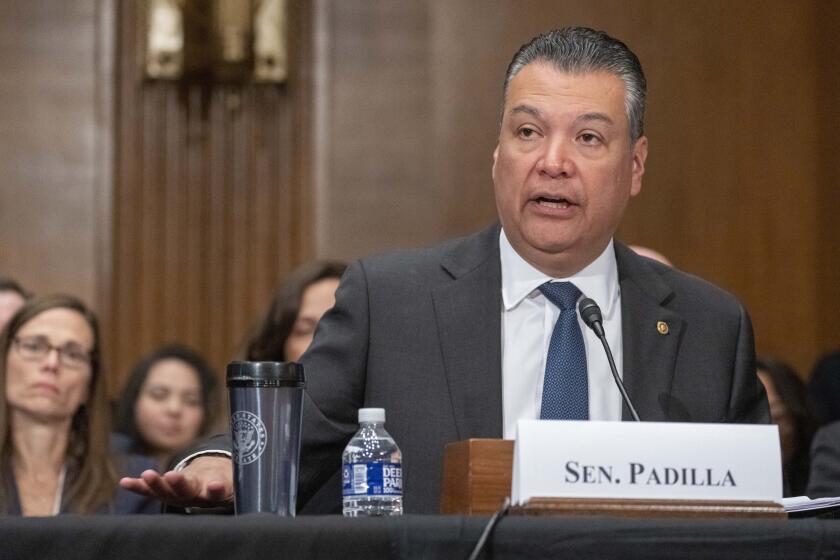Opinion: The mental health crisis hotline is working. So why doesn’t it get the funding it needs?

- Share via
The 988 suicide and crisis lifeline remains one of the most significant, easily accessible resources ever created to help people in crisis. So two years after its launch, why aren’t states investing more to meet the demand for its services?
Since it went live on July 16 of 2022, 988 — which is available 24/7 and can be reached by calling or texting the number or using its online chat service — has received more than 10 million contacts. In May 2024 alone, 610,378 calls, texts and chat messages were routed to 988, according to data from the Substance Abuse and Mental Health Services Administration. That’s a 47% increase from 413,425 in August 2022, its first full month in service.
The purpose of the lifeline is to connect people experiencing a mental health emergency to crisis care resources. Addison Eggebeen, 15, firmly believes that dialing 988 last year was the most important call she’s ever made.
‘Deaths of despair’ caused by drug overdoses, suicide and liver disease due to alcoholism have risen among Americans of color. Here’s how to find help.
“I would say it saved my life because I didn’t know how far I would take my suicidal thoughts,” Addison told me. “It sounds like I’m supposed to say it, but I don’t know if I would be here if it wasn’t for 988.”
The staggering demand for — and impact of — the suicide and crisis lifeline is all the evidence we need to continue investing in 988 and working to reach even more people. The only way to make 988 a comprehensive, coordinated crisis response system is through continued investment, innovation and collaboration.
One challenge is that too many states have neglected to establish a reliable funding source for 988. Following the model established by 911, states have the authority to fund the lifeline by authorizing telecom companies to collect modest fees from customers. While states widely use surcharges on cellphone bills to fund 911 services, only 10 states have passed comprehensive laws to ensure 988 funding, according to a report published in June.
Another significant challenge is that local and regional 988 call centers are stretched thin. Monica Johnson, the director of the 988 and behavioral health crisis coordinating office at the Substance Abuse and Mental Health Services Administration, noted this year that the burnout afflicting the broader healthcare industry has hurt this workforce too. Although about 90% of calls to 988 are answered nationally, Nevada’s response rate, the worst in the country, is only 63%. The state has around 35 staff members answering the calls.
L.A. County says it needs a federal fix to make sure Angelenos with out-of-town area codes can access local services when they call 988.
A workforce shortage also limits the services to which call centers can connect people. These organizations — clinics providing mental health and substance use treatment, mobile crisis response, post-crisis care and stabilization — are the backbone of crisis response. They also struggle with recruitment and retention. A survey last year of our members at the National Council for Mental Wellbeing found that providers’ waiting lists are increasing and they are seeing more than the optimum number of clients. They’re in dire need of more peer specialists, social workers, case managers, psychiatrists, nurse practitioners, other mental health and substance use professionals and administrative staff.
Improving recruitment and retention at both call centers and behavioral health providers will help to ensure that people can contact the lifeline without delays and get appropriate services. In addition, it’s important to bolster coordination. Call centers must have direct access to mobile outreach teams, walk-in facilities and outpatient care options. The 988 lifeline is an entry point to services as wide-ranging as mobile crisis response, walk-in urgent care, hospitalization, residential crisis services and intensive crisis outpatient services. They all have to work together to strengthen the continuity of care.
The government must also leverage technology. The Federal Communications Commission has taken the first step toward adopting a rule that would require telecommunications companies to route calls to 988 based on the caller’s physical location rather than to a call center in their area code. Geo-routing wireless calls through the nearest cell tower, and to the nearest call center, would allow a 988 operator to connect a person in crisis with resources closest to them.
Flipping the switch on 988 was a massive effort requiring coordination among federal, state and local authorities. That effort has paid off, but there’s more to be done to ensure that the lifeline is a reliable gateway to crisis care. No one is immune from a mental health or substance use challenge, and the demand for this care is rising. Nearly 50,000 individuals in the U.S. took their own lives in 2022, a 3% increase from 2021, according to provisional data from the Centers for Disease Control and Prevention’s National Center for Health Statistics.
So let’s do all we can to support 988 and the people like Addison who need it.
Chuck Ingoglia is president and chief executive at the National Council for Mental Wellbeing.
More to Read
A cure for the common opinion
Get thought-provoking perspectives with our weekly newsletter.
You may occasionally receive promotional content from the Los Angeles Times.












